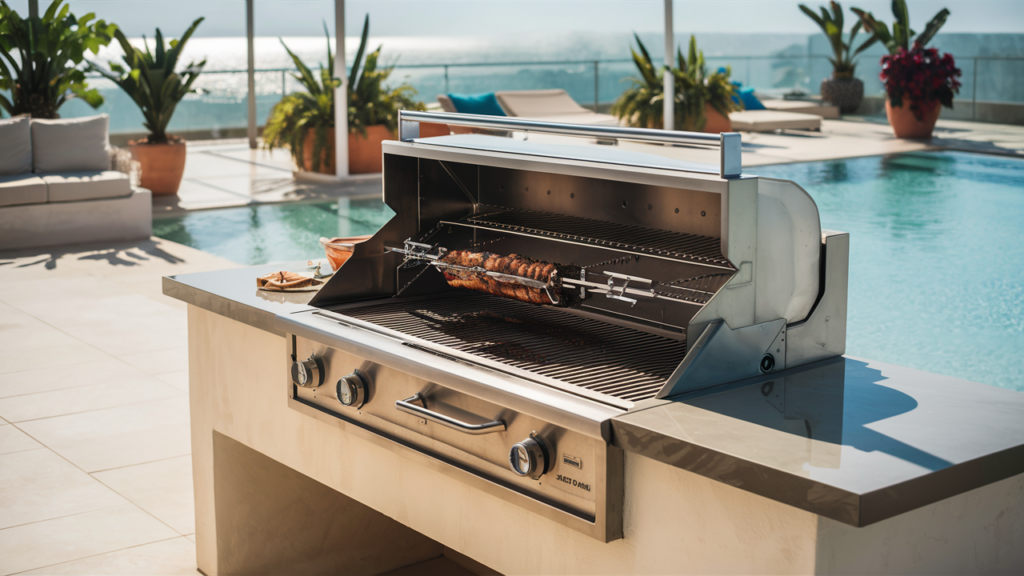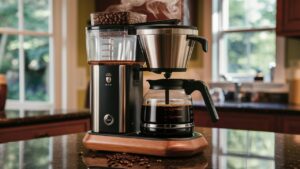Are you trying to decide between an indoor grill and an outdoor grill for your next culinary adventure? The choice might seem simple, but each option offers unique benefits that can enhance your cooking experience.
Imagine the convenience of grilling juicy steaks right in your kitchen, or the pleasure of savoring smoky flavors under the open sky. Your decision could transform your meals and even your lifestyle. You’ll uncover everything you need to know to make the perfect choice for your needs.
Get ready to discover how each grill type can elevate your cooking game and bring new flavors to your table. Don’t miss out on finding the grill that can turn your meals into memorable experiences.
Grilling Basics
Grilling offers a unique cooking experience that brings out flavors in food like no other method. Whether you choose an indoor or outdoor grill, understanding the basics can elevate your grilling game. Let’s break down what makes each type special and how you can use them effectively.
Indoor Grills Explained
Indoor grills are perfect for those who love grilling but live in apartments or areas with limited outdoor space. They are compact and can fit on your kitchen counter. Most models come with electric heating elements, making them easy to use and clean.
Think of indoor grilling as an extension of your kitchen cooking. You can prepare grilled vegetables and sandwiches without worrying about the weather. Want to grill a steak for dinner? An indoor grill can achieve that seared perfection without the smoke.
Many indoor grills have adjustable temperature settings. This allows you to experiment with different cooking styles. Have you ever tried grilling fruit? It’s a delightful surprise that an indoor grill can offer, adding a sweet touch to your meals.
Outdoor Grills Explained
Outdoor grills are the go-to choice for those who enjoy the traditional grilling experience. They’re typically larger and can handle more food at once. They run on gas, charcoal, or wood, each offering distinct flavors.
Cooking outdoors offers a sense of adventure. Imagine hosting a barbecue in your backyard with friends and family. The smoky aroma and sizzle of meat create an unforgettable atmosphere. Outdoor grills also allow for versatility, from slow cooking ribs to quick searing burgers.
Outdoor grills often have features like side burners and rotisserie attachments. This expands your cooking options beyond the basics. What’s stopping you from trying a grilled pizza? With an outdoor grill, the sky is the limit.
As you consider your grilling options, think about your lifestyle and space. Which setup fits you best? Whether indoor or outdoor, mastering the basics will bring joy to your meals and gatherings.
Convenience Factor
Grilling is a beloved culinary tradition. Choosing between indoor and outdoor grills often boils down to convenience. The setup, ease of use, and cleaning process are crucial factors. Each type offers unique benefits. Understanding these can enhance your grilling experience.
Setup And Storage
Indoor grills are compact. They fit easily on kitchen counters. You can store them in cabinets or drawers. Outdoor grills require more space. They need a dedicated area in your backyard. They might need covers for protection against weather.
Ease Of Use
Indoor grills are plug-and-play. No need for charcoal or gas. They heat up quickly. Outdoor grills require fuel like charcoal or propane. They may take longer to reach cooking temperature. Adjusting heat on indoor grills is straightforward. Outdoor grills need more attention to maintain the right heat.
Cleaning And Maintenance
Cleaning indoor grills is simple. Non-stick surfaces make it easy. Removable plates often go in the dishwasher. Outdoor grills require more effort. Scrubbing grates and drip trays can be time-consuming. Regular maintenance is necessary for safety and longevity.
Flavor And Cooking Techniques
Explore the unique flavors and cooking techniques of indoor and outdoor grills. Indoor grills offer convenience and consistent heat, making them perfect for controlled cooking. Outdoor grills add rich smoky aromas, providing a traditional barbecue experience and enhancing the taste of grilled foods.
Flavor and cooking techniques form the heart of grilling. Whether indoors or outdoors, grilling offers unique experiences. Each method brings out different flavors and textures. Understanding these differences helps you choose the right grill for your needs.
Heat Source Differences
Indoor grills often use electricity as their heat source. This provides consistent, controllable heat. Outdoor grills usually burn charcoal or gas. Charcoal imparts a smoky flavor. Gas heats quickly and evenly. Both sources affect the final taste of the food.
Flavor Profiles
Indoor grills give a clean taste. The absence of smoke is noticeable. This is ideal for delicate foods. Outdoor grills add depth and complexity. Charcoal enhances the smoky aroma. Gas grilling maintains natural flavors. Each method offers unique flavor profiles.
Cooking Versatility
Indoor grills are great for quick meals. Their compact size fits small spaces. They are perfect for apartments. Outdoor grills handle larger quantities. They are ideal for parties and gatherings. You can cook various foods at once. Each grill type offers distinct cooking versatility.
Cost Considerations
Grilling enthusiasts often face the dilemma of choosing between an indoor and outdoor grill. One of the most significant factors influencing this decision is cost. Whether you’re a seasoned griller or just starting out, understanding the cost implications of each option can help you make an informed choice. Let’s dive into the specifics of initial investment and operational costs.
Initial Investment
When considering the initial investment, indoor grills often present a more budget-friendly option. These grills can range from as low as $30 for basic models to a few hundred dollars for high-end versions with advanced features.
If you’re looking for a simple way to start grilling without breaking the bank, an indoor grill might be your best bet. On the other hand, outdoor grills, especially those powered by gas or charcoal, typically require a larger financial commitment. You might be looking at spending anywhere from $100 to several thousand dollars.
It’s important to consider what features matter most to you. Do you want a grill with multiple burners or just a simple setup? Assessing your needs can help you allocate your budget effectively. Have you ever found yourself regretting an impulsive purchase? Careful planning can help you avoid that pitfall.
Operational Costs
Operational costs can vary significantly between indoor and outdoor grills. With indoor grills, the primary operational cost is electricity. You can easily estimate this by checking your local electricity rates and the grill’s power usage.
Outdoor grills, especially those using charcoal, have ongoing costs for fuel. Charcoal can add up quickly if you grill often. Gas grills, while more economical than charcoal, still require regular refills of propane tanks.
Consider how often you’ll be grilling. Will you be firing up your grill every weekend, or is it reserved for special occasions? Frequent usage can make operational costs a crucial factor in your decision-making process. Are you prepared for the long-term expenses associated with your grilling choice?
Understanding these cost considerations can help you make a choice that aligns with your lifestyle and budget. What’s your priority—initial savings or long-term efficiency? The answer could guide you toward the right grill for your needs.

Safety Aspects
Grilling is a beloved culinary tradition, but safety should always be a top priority whether you’re cooking indoors or outdoors. When you weigh the pros and cons of indoor versus outdoor grills, safety aspects often play a crucial role in your decision-making process. Let’s dive into the specific safety concerns associated with each option and see how you can protect yourself and your loved ones while enjoying delicious grilled meals.
Indoor Safety Concerns
Cooking indoors presents unique safety challenges. The most significant risk is ventilation. Without proper ventilation, carbon monoxide from indoor grills can accumulate. This invisible gas is dangerous and can lead to poisoning.
Ensure you have a working exhaust fan or open windows when using an indoor grill. This provides the necessary airflow and keeps harmful fumes at bay. It’s a simple step that can save lives.
Another aspect to consider is the space around your indoor grill. Make sure the grill is not near flammable materials such as curtains or kitchen towels. Keep your cooking area clear to prevent accidents. A small space can quickly become hazardous if not managed properly.
Outdoor Safety Concerns
Outdoor grilling brings its own set of safety concerns. One major consideration is weather conditions. Wind can blow flames towards unexpected areas, leading to potential fires. Always check the weather forecast before setting up your grill outside.
Position your outdoor grill away from buildings, trees, and dry grass. These can catch fire easily if exposed to heat or flames. Think about your surroundings and choose a safe spot for grilling.
Another key point is the stability of your grill. Ensure it’s on a flat surface to prevent tipping. A secure grill reduces the risk of accidents and helps you grill with peace of mind. Have you ever had a grill tip over? It’s a scary experience you don’t want to repeat.
Safety is crucial whether you’re grilling indoors or outdoors. By understanding the specific risks and taking preventative measures, you can ensure a safe and enjoyable grilling experience. What safety steps do you take when you grill? Share your thoughts and tips in the comments below!
Weather And Seasonality
Choosing between indoor and outdoor grills depends on the weather and season. Indoor grills offer convenience during rainy or cold days. Outdoor grills are perfect for sunny days, adding a smoky flavor to your meals.
Grilling enthusiasts often face the dilemma of choosing between indoor and outdoor grills, especially when considering the impact of weather and seasonality. Each option offers unique benefits, but how does the weather factor into your grilling experience? Let’s explore how the changing seasons can influence your decision-making process.
###
Year-round Grilling
Indoor grills shine when it comes to year-round usability. With an indoor grill, you can cook your favorite meals regardless of rain, snow, or extreme temperatures. Imagine grilling juicy steaks in the comfort of your kitchen while a snowstorm rages outside.
Outdoor grills, however, often depend on favorable weather conditions. While some grill enthusiasts brave the elements to cook outside, others may find themselves limited by cold or wet weather. Consider if you’re ready to tackle the rain for a perfect barbecue.
###
Weather Limitations
Weather can significantly limit your outdoor grilling opportunities. Rainy days might dampen your plans for a backyard barbecue. High winds can make it difficult to control cooking temperatures, leading to unevenly cooked food.
Indoor grills eliminate these limitations, offering a controlled environment for your grilling adventures. You won’t have to watch the weather forecast before planning a meal. Enjoy the consistency and convenience of indoor cooking without the unpredictability of outdoor conditions.
Have you ever canceled a cookout due to unexpected weather? You might want to weigh these factors carefully. Whether you value the flexibility of indoor grilling or the authentic experience of outdoor cooking, consider how weather and seasonality impact your grilling lifestyle.
Health Implications
Grilling is a popular cooking method for many households. Choosing between an indoor or outdoor grill involves considering health implications. Each type has its own impact on health, from smoke production to nutritional content. Understanding these differences helps you make informed decisions.
Smoke And Air Quality
Outdoor grills often produce more smoke. This smoke can disperse in the open air. Indoor grills have better smoke control. They often come with built-in smoke filters. This can reduce indoor air pollution. Consider ventilation when using an indoor grill. Proper ventilation ensures smoke does not linger.
Nutritional Aspects
Grilling helps retain nutrients in food. Both indoor and outdoor grills offer this benefit. The direct heat seals in juices and flavors. This can result in healthier, tastier meals. Indoor grills often have non-stick surfaces. These surfaces require less oil for cooking. Reduced oil means fewer calories.
Outdoor grills may allow fat to drip away. This can reduce the overall fat content. Both grill types provide a method to cook without excess fat. This can lead to healthier meals.
Social And Lifestyle Impact
Indoor grills offer convenience and ease, perfect for quick meals and urban living. Outdoor grills enhance social gatherings, creating memorable experiences with friends and family in open spaces. Each choice shapes lifestyle and social interactions uniquely.
When deciding between an indoor grill and an outdoor grill, many people focus on the taste and convenience. However, the impact on your social life and lifestyle should not be overlooked. Grilling is not just about food; it’s an experience that brings people together and complements your daily habits.
Social Gatherings
Hosting a barbecue can be the highlight of your social calendar. An outdoor grill naturally invites larger gatherings. Picture friends and family chatting in your backyard, kids playing in the open space, and the aroma of grilled food filling the air.
But what if you live in an apartment or a place with unpredictable weather? That’s where an indoor grill shines. It allows you to host intimate dinner parties year-round, regardless of the forecast. You don’t need to worry about rain ruining your plans or space limitations.
Consider how each option aligns with your social life. Do you prefer large parties or cozy gatherings? Your choice of grill can enhance your hosting style.
Lifestyle Preferences
Your lifestyle plays a crucial role in deciding between an indoor or outdoor grill. If you love spending time outside and have a spacious yard, an outdoor grill fits naturally into your routine. It encourages you to enjoy the sunshine while preparing meals.
On the other hand, if you lead a busy life and cherish convenience, an indoor grill might be better suited. It offers quick setup and cleanup, perfect for those with limited time. Imagine coming home after a long day and easily preparing a grilled meal without the hassle of firing up a large grill.
Think about your daily habits. Do you have time to maintain an outdoor grill? Or do you need something quick and efficient for weeknight dinners? Your lifestyle preferences can guide you to the right choice.
Ultimately, your grill choice can shape your social interactions and daily life. So, what does your perfect grilling experience look like?
Making The Right Choice
Choosing between an indoor or outdoor grill can be tricky. Each type offers unique benefits. Your decision should align with your lifestyle and needs. Consider your personal preferences, space availability, and grilling goals. These factors will guide you to the perfect grill for your home.
Personal Preferences
Your cooking style influences your grill choice. Love searing steaks over an open flame? An outdoor grill might be ideal. Prefer a smokeless, convenient option? An indoor grill could be your best bet. Think about ease of use, clean-up, and flavor.
Space Availability
Available space plays a crucial role in your decision. An outdoor patio or yard can accommodate larger grills. Small apartments may limit you to compact, indoor models. Always measure your space before purchasing. Ensure you have adequate room for grilling and safety.
Grilling Goals
Define your grilling objectives. Planning to host large BBQ gatherings? An outdoor grill provides capacity and flair. Seeking a simple, quick meal solution? Indoor grills offer speed and convenience. Your goals will shape the best option for you.
Frequently Asked Questions
What Is The Point Of An Indoor Grill?
An indoor grill provides convenient, year-round grilling without outdoor elements. It offers quick cooking, easy cleanup, and healthier meals. Ideal for apartments or small spaces, it delivers delicious, grilled flavors at home. Enjoy versatile cooking options with minimal smoke, enhancing your culinary experience.
Can You Use An Indoor Grill Outside?
Yes, you can use an indoor grill outside. Ensure it’s on a stable surface and protected from weather. Keep it away from flammable materials. Follow safety guidelines and use an extension cord if needed. Make sure it’s suitable for outdoor use to avoid damage.
Do Indoor Grills Taste Like Outdoor?
Indoor grills can mimic outdoor flavors but lack the smoky taste. They use electric heat, not charcoal or gas. Some indoor grills add a slight char, but results vary. Marinades and seasonings enhance flavor. Outdoor grills still provide a more authentic smoky taste.
Can I Use My Existing Grill In An Outdoor Kitchen?
Yes, you can use your existing grill in an outdoor kitchen. Ensure it fits properly and meets safety standards. Check for sufficient ventilation and space. Consider the grill’s compatibility with your kitchen design for seamless integration.
Conclusion
Choosing between an indoor and outdoor grill depends on your needs. Indoor grills suit small spaces. They offer convenience and easy cleaning. Outdoor grills provide a classic barbecue experience. Perfect for larger gatherings and authentic flavors. Consider your lifestyle and cooking preferences.
Both types have their own benefits. Think about space, weather, and personal taste. Whether inside or outside, grilling brings joy. Enjoy the delicious results with family and friends. Whichever grill you choose, savor the moments and flavors. Happy grilling!








